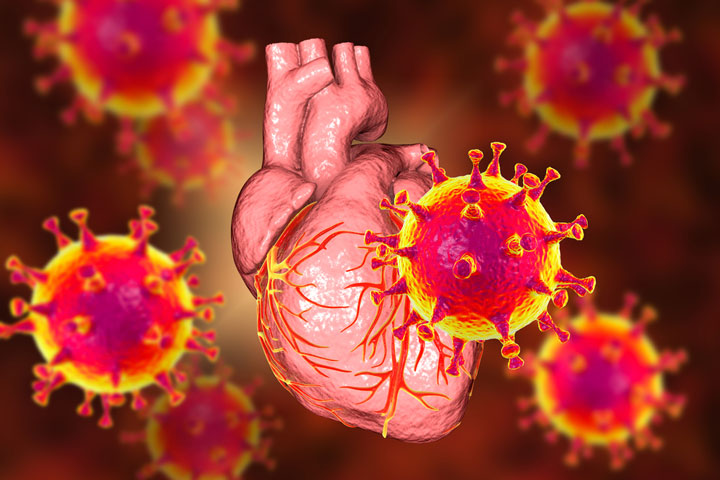Raising awareness can help mitigate negative outcomes.
Takeaways:
- In a COVID-19 pandemic and vaccination world, nurses should raise their clinical suspicion for myocarditis when healthy, young, or athletic patients present with fatigue, palpitations, and chest pain.
- Understanding the basic mechanisms underlying myocardial injury from COVID-19 and who’s at risk can aid prompt identification.
- Continuing research will help healthcare professionals stratify the clinical implications and long-term impact of symptomatic and asymptomatic COVID.
This is an early release of a web exclusive article for the October 2021 issue of American Nurse Journal.
Myocarditis—inflammation of the heart muscle (myocardium)—is an emerging long-term sequela of COVID-19 that primarily affects young, healthy athletes. Consider National Hockey League rookie Marco Rossi. During a routine medical screening, laboratory tests showed myocarditis, making him vulnerable to cardiac abnormalities. Marco had no symptoms and believed he’d fully recovered from COVID-19 about 2 months before. The screening and proper myocarditis diagnosis may have prevented serious negative outcomes.
Many consider athletes to be models of good health, so the community takes notice when they fall ill. Although anyone with COVID-19 can contract myocarditis, the risk is highest in those with exertional demands on their heart. According to research by Brito and colleagues, one in three healthy college athletes recovering from COVID-19 showed imaging features of resolving pericardial inflammation.
Unfortunately, in both athletes and the general population, those with myocarditis caused by COVID-19 often don’t report cardiac symptoms, and they can have the condition with few or no COVID-19 symptoms.
Healthcare professionals must recognize the widespread epidemiological impact of COVID-19 and the potential for unsuspected and occult cardiac damage, focusing on the injury potential from exertional oxygen demand, such as that experienced during exercise.
COVID-19–myocarditis connection
Mahenthiran and colleagues report that myocardial injury and right ventricular dysfunction are the most frequently reported cardiovascular manifestations of COVID-19. Dou and colleagues identified many myocardial effects, including acute cardiac injury, myocarditis, arrhythmias, heart failure, thrombolytic events, and shock.
COVID-19-related cardiovascular effects seem to be the byproduct of a range of physiologic responses connected to the virus, although more research is needed. For example, as is the case with other systemic infections caused by viruses (such as Coxsackievirus and influenza), COVID-19 causes increased oxygen demands on the myocardium as the body mounts a vigorous metabolic response. Because effective heart function depends on a balance of myocardial oxygen supply and demand, a compromised heart experiencing increased demand (such as exercise), can aggravate any underlying cardiac conditions.
In addition, direct viral burden and indirect pressure on the cardiovascular system can result in cytokine damage, microvascular dysfunction, coagulation derangements, and systemic inflammation. Inflammatory infiltrates, which affect the middle layer of cardiac muscle, frequently are present with nonischemic myocarditis and myocardial injury.
Symptoms of myocarditis can be nonspecific, including chest pain, dyspnea, and palpitations. Nalbandian and colleagues report that patients with minimal COVID-19 symptoms can show evidence of persistent cardiac abnormalities and dysfunction several months after recovery.
Who’s at risk?
Daniels and colleagues found a prevalence of 2.3% of clinical or subclinical COVID-19 myocarditis among 1,597 college athletes, which is concerning given that myocarditis is one of the leading causes of sudden cardiac death among competitive athletes.
Some of those athletes may be at higher risk. The Centers for Disease Control and Prevention (CDC) states that American Indian, Alaska Native, Black, and Hispanic populations experience disproportionate rates of illness and death because of COVID-19. According to the University of Southern California Race and Equity Center, Black undergraduate men make up more than half of college football teams and two-thirds of men’s basketball players, representing a vulnerable population with a long history of underlying disparities.
But it’s not just athletes who are at risk. Exercising while infected with the virus can increase the risk of developing myocarditis. Anyone who has had COVID-19 should receive clearance from their primary care provider before restarting an exercise regimen.
Vaccine
Post-vaccination myocarditis has occurred after the second dose of mRNA COVID-19 vaccination (Pfizer-BioNTech, Moderna) in individuals under age 30. In research from Marshall and colleagues, seven cases of acute myocarditis or myopericarditis occurred in healthy male adolescents who reported chest pain within days of their second Pfizer-BioNTech COVID-19 vaccination. According to the CDC, 1,339 reports of heart inflammation (myocarditis and pericarditis) after mRNA COVID-19 vaccination in adults under age 30 have been made to the Vaccine Adverse Event Reporting System (VAERS) (as of August 18, 2021). Through follow-up, including medical record reviews, the CDC and Food and Drug Administration have confirmed 778 reports and are investigating them.
In proportion to the hundreds of millions of safe vaccine doses administered, these numbers are small, and the CDC continues to recommend COVID-19 vaccination for those 12 years and older.
In the VAERS reports, chest pain was the primary symptom, usually occurring within several days of vaccination. Symptoms typically resolve in days and require consultation with a primary care provider before returning to exercise. When patients under age 30 report chest pains, clinicians should ask about recent COVID-19 vaccinations and assess for risk of myocarditis.
Nursing implications
All healthcare professionals must recognize the potential for cardiac involvement resulting from COVID-19. Nurses should develop a high degree of clinical suspicion about lingering cardiac symptoms (including fatigue, palpitations, and chest pain) and reconsider what qualifies as cardiac damage in healthy individuals and those reporting prior self-limiting symptoms from a viral illness.
Chest pain poses a difficult diagnostic challenge, and some patients who’ve recovered from COVID-19 may have myocarditis with no symptoms. Routine cardiac evaluation of individuals you suspect have myocarditis may yield elevated serum troponin, asymptomatic cardiac arrhythmias, and cardiac imaging abnormalities. ECGs may disclose cardiac ischemia, myocarditis, and arrhythmias. Detailed histories and physicals may indicate potential myocarditis in asymptomatic individuals, and imaging can help identify an enlarged cardiac silhouette. If you suspect heart failure, laboratory testing should include cardiac biomarkers for myocardial damage and NT-pro B-type natriuretic peptide.
Any return to physical exercise requires risk stratification. Individuals with a history of severe COVID-19 warrant further clinical assessment, especially those with underlying cardiac disease. Your goal should be to identify and reduce the risk of cardiac injury, particularly in those participating in moderate-to-significant exercise.
Future best practices
As our understanding of the underlying pathology of COVID-19 grows, preliminary findings suggest that demand ischemia, endothelial compromise, viral toxicity, mechanical dysfunction, and systemic inflammation play critical roles in evoking functional cardiac abnormalities. Additional research will help healthcare professionals stratify the clinical implications and long-term impact of these abnormalities in patients with symptomatic and asymptomatic COVID-19.
All healthcare professionals should understand the potential cardiovascular effects of COVID-19 and help establish well-defined guidelines. Developing future best practices won’t be possible without the rigorous collection of data to determine the true prevalence of cardiac involvement in patients who’ve had COVID-19.
R.E. Hengsterman is a staff nurse at Duke University Medical Center in Durham, North Carolina.
References
Brito D, Meester S, Yanamala N, et al. High prevalence of pericardial involvement in college student athletes recovering from COVID-19. JACC Cardiovasc Imaging. 2021;14(3):541-55. doi:10.1016/j.jcmg.2020.10.023
Centers for Disease Control and Prevention. Health equity considerations and racial and ethnic minority groups. April 21, 2021. cdc.gov/coronavirus/2019-ncov/community/health-equity/race-ethnicity.html
Centers for Disease Control and Prevention. Myocarditis and pericarditis following mRNA COVID-19 vaccination. September 8, 2021. cdc.gov/coronavirus/2019-ncov/vaccines/safety/myocarditis.html
Centers for Disease Control and Prevention. Selected adverse events reported after COVID-19 vaccination. September 2, 2021. cdc.gov/coronavirus/2019-ncov/vaccines/safety/adverse-events.html
Daniels CJ, Rajpal S, Greenshields JT, et al. Prevalence of clinical and subclinical myocarditis in competitive athletes with recent SARS-CoV-2 infection: Results from the Big Ten COVID-19 cardiac registry. JAMA Cardiol. 2021;e212065. doi:10.1001/jamacardio.2021.2065
Dolgin E. COVID’s cardiac connection. Nature. 2021;594(7862):S14-5. doi:10.1038/d41586-021-01456-3
Dou Q, Wei X, Zhou K, Yang S, Jia P. Cardiovascular manifestations and mechanisms in patients with COVID-19. Trends Endocrinol Metab. 2020;31(12):893-904. doi:10.1016/j.tem.2020.10.001
Harper SR. Black male student-athletes and racial inequities in NCAA division I college sports. University of Southern California Race and Equity Center. 2018. abfe.issuelab.org/resources/29858/29858.pdf
Mahenthiran AK, Mahenthiran AK, Mahenthiran J. Cardiovascular system and COVID-19: Manifestations and therapeutics. Rev Cardiovasc Med. 2020;21(3):399-409. doi:10.31083/j.rcm.2020.03.124
Marshall M, Ferguson ID, Lewis P, et al. Symptomatic acute myocarditis in 7 adolescents after Pfizer-BioNTech COVID-19 vaccination. Pediatrics. 2021;148(3):e2021052478. doi:10.1542/peds.2021-052478
Nalbandian A, Sehgal K, Gupta A, et al. Post-acute COVID-19 syndrome. Nat Med. 2021;27(4):601-15. doi:10.1038/s41591-021-01283-z


















